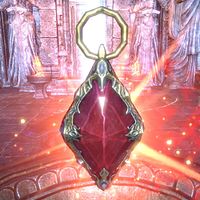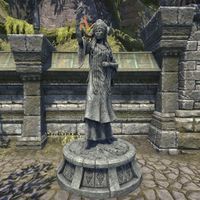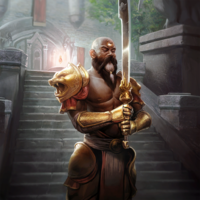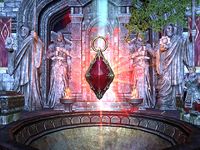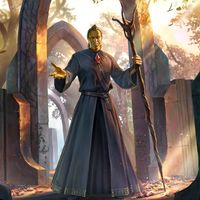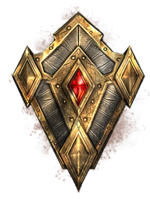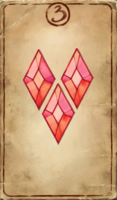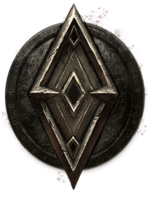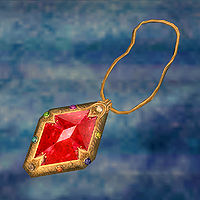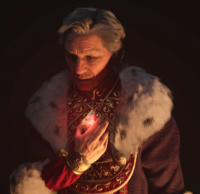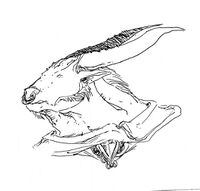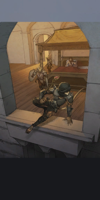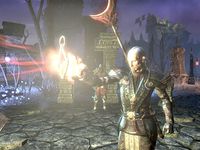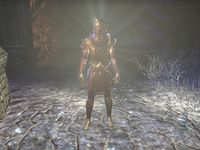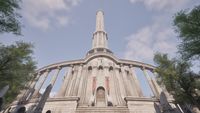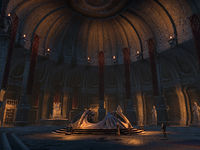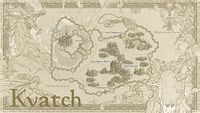Lore:Amulet of Kings
The Amulet of Kings, also called the Amulet of the Kings of Glory,[1] was a pendant traditionally worn by the ruling emperor of Cyrodiil. Set in its center was the Chim-el Adabal, also known as the Red Diamond,[2] a huge soul gem of Ayleid origin, and Aedric relic,[3] said to contain the divine power of Akatosh.[4] It was held in a golden clasp surrounded by eight smaller gems that represented the Eight Divines of the original Cyrodilic pantheon, created by Queen Alessia. It served as the symbol of the divine right of the Cyrodilic emperors. The amulet was an important component of the coronation ceremony and a powerful artifact when used for divination. The soul of each reigning emperor was enshrined within the central stone, presumably during the coronation ritual involving the Dragonfires and the divine Covenant. In this way Cyrodiil's rulers were brought together in death, forming an 'oversoul' that could provide counsel to their successors. The oversoul of emperors was capable of describing events that occured within a Dragon Break, where even the Elder Scrolls could not.[5] The amulet could only be worn by certain individuals—those who could wear it were said to have the 'Dragon Blood' in their veins. The specific requirements, however, have been a subject of debate, and they may simply have called for the attributes of a ruler or some divine mandate.[6]
The Amulet of Kings was the Stone of the White-Gold Tower, a focal point for the Tower's reality altering power, upon which the rules according to which White-Gold shaped its domain, were inscribed.[UOL 1][7] It was described by Mannimarco as the most powerful Soul Gem ever created, an artifact through which all things were made possible, even imprisoning the animus of a god and using it to achieve Apotheosis.[8]
The Amulet was used by the Dragonborn emperors during their coronation, as part of the ritual to relight the Dragonfires in the Temple of the One and thereby renew the Liminal Barriers separating Mundus from Oblivion.[9][10][11] Though the coronation ritual took place in the Temple of the One, the source of the Dragonfires was the Sublime Brazier, a sacred cauldron located in the Dragonfire Cathedral deep beneath the Imperial Sewers, said to stretch to the very heart of Nirn and described as Akatosh's "first light".[12]
The Amulet of Kings is a sacred symbol of the Empire, although most people think of the Red Dragon Crown as the Empire's main symbol of power.[13] The Red Diamond has also become a symbol heavily associated with Imperials.[14]
History[edit]
First Era[edit]
—An excerpt from Trials of St. Alessia
The Amulet of Kings entered the annals of human history when Akatosh (in some stories Shezarr)[UOL 2] forged the Covenant with Alessia and her (symbolic) descendants while she lay in her death bed. Chim-el Adabal was fastened in an amulet and became the symbol of both the Covenant and the legitimacy of Cyrodiil's rulers.[2][11] A popular song in the Second Era however, claimed that the Chim-el Adabal was formed when a drop of blood fell from the Heart of Lorkhan as it was flung to Tamriel, and landed down an Ayleid Well, the magicka within fusing it to a strong red crystal, which the Ayleids fashioned it into a great gem.[15] One of the stories about Rajhin's most legendary heists claim he had stolen the Amulet of Kings from Alessia for a time.[16]
During the Middle Dawn, it is said that the Elder Council questioned the oversoul of emperors within the Amulet on what had occured during the phenomenon. Though even the Elder Scrolls could not speak of what had occured during the untime, the oversoul is said to have spoken of the event at length. According to Empress Hestra, Cyrodiil became an Empire across the stars and, according to Shor-El, Cyrodiil became an egg. The accounts of most emperors were said to have been spoken in a language that could only be spoken sideways.[5]
Following the breakup of the Alessian Empire, the Amulet of Kings was lost amid chaotic civil war and its attendant looting. According to legend, a certain King Hrol tracked down the spirit of Saint Alessia, who wore the Amulet of Kings around her neck. They coupled, and a hill named Sancre Tor rose on the spot. The infant Reman Cyrodiil was found upon the crest, wearing the amulet on his brow.[17] The Amulet of Kings was restored to prominence during the Reman years, lending legitimacy to that dynasty. After that time, the Dragonfires ritual became essential to the coronation of each new Emperor. During the ritual, the new monarch was soul-linked to the Amulet of Kings and sent to the Temple of the One to light the enchanted Dragonfires, which then burned until his death.[18]
Second Era[edit]
In the middle of the Second Era, the Five Companions embarked on a quest to rediscover the Amulet of Kings. Their leader, Varen Aquilarios, was led to believe that the Amulet could be used in a ritual which would rekindle the Dragonfires and make him a true Dragonborn. This would allow him to be recognized as the legitimate ruler of the Empire. After years of searching, the Companions eventually found the Amulet. In 2E 579, they initiated the ritual in the Imperial City. It was then that Mannimarco, another one of the Companions, revealed his treachery and corrupted the ritual to break the ancient covenant between Akatosh and mortals, a feat achieved through the inscription of arcane runes over a number of weeks.[1] This caused the catastrophic event known as the Soulburst which sundered the veil between worlds and set Nirn adrift in Oblivion, making it become "unmoored from the fabric of the multiverse", causing mages to go mad, unleashing natural disasters and mystical aftershocks across the world, and making the Serpent constellation appear so large it seemed to threaten all other star-signs at once. This event disrupted the connection between Nirn's inhabitants and their souls, and served as the precursor to Molag Bal's Planemeld.[19][20] In the subsequent chaos, Sai Sahan took the Amulet of Kings and fled. He then hid it within the ruins of Sancre Tor.
The Amulet was recovered from Sancre Tor in 2E 582 by the Vestige, Abnur Tharn, Sahan and Lyris Titanborn, retrieved in Sancre Tor after the defeat of Mannimarco, who had been planning to use it to imprison Molag Bal and use his spirit to become a Daedric Prince himself.[8] It was later used by Abnur Tharn to perform the ritual which imbued the Vestige with the power of Akatosh. However, one of the Companions had to be sacrificed in the process. With the power granted by the ritual, the Vestige was able to defeat Molag Bal, forcing him to relinquish his grip on Nirn, and reclaim their soul.[21][22][23] After Molag Bal's defeat, Abnur Tharn took the amulet and fled to Cyrodiil. Although it was suspected he would attempt to use it, unbeknownst to him the amulet's power had been expended for at least a generation, and he was not of the proper lineage to use it, thus making the attempt futile by his own admission.[24][25].
After the long decline of the Interregnum, General Talos reputedly recovered the amulet from the tomb of the Remans beneath Sancre Tor after retaking it from the Nordic and Breton invaders.[18]
Third Era[edit]
The Hero of Kvatch recovered the amulet from the depths of the Imperial Subterrane after the assassination of Emperor Uriel Septim VII at the hands of Daedric cultists. The Hero then delivered it to the Grandmaster of the Blades. After escorting Martin, Uriel's illegitimate son, back to Grandmaster Jauffre, the Amulet was stolen by the Mythic Dawn. The Hero was forced to enter the Paradise of Mankar Camoran in order to recover it. This achieved, preparations were made for Martin's coronation, but the ceremony was interrupted by a Daedric assault on the capital. After fighting his way to the Temple of the One, Martin was forced to smash the amulet, this being the only way to defeat Mehrunes Dagon. The power of the intermingled blood of the Covenant summoned a rare Aedric avatar in the form of Akatosh, a fiery dragon, thereby also causing Martin to Mantle Akatosh and achieve Apotheosis, according to some sources.[UOL 3][UOL 4]. Dagon was defeated, and the sacrifice "sealed the gates of Oblivion forever", ensuring that the Daedra could never again threaten the people of Tamriel. The new barrier was noted to be too powerful for even a Sigil Stone, an object in the presence of which it was said even "a thousand soul gems would likely dissolve", to breach for more than fleeting moments.[26][4][9][27] The near four thousand year history of the Amulet of Kings was ended.[28]
Cultural Importance[edit]
The Red Diamond is the symbol of the Empire and the Nine Divines.[29][30] It is based on the Chim-el Adabal, the cut red soul gem in the center of the Amulet of Kings.[31][2]
Gallery[edit]
Belharza wearing the Amulet under his cloak
Notes[edit]
- An Amulet of Kings replica was made available as official merchandise.
- The name of the crystal in the center of the amulet, "Chim-el Adabal", can be translated to Royalty[32] High Spirit[33] Stone;[34] thus, the Spirit Stone of High Royalty.[UOL 5]
- At some point after the Soulburst, mysterious slate-skinned figures, known as Red Diamond Guardians, periodically appeared in the Imperial City to fight the Daedra. Each one had the Red Diamond encrusted upon their torso. No one knew where they came from or where they went after each fray.[35]
- In an alternate reality, Mannimarco's plan to replace Molag Bal as the Prince of Domination succeeded, and he presided over the Imperial City from a throne formed of bone and souls placed above the White-Gold Tower.The world was plunged into darkness, flooded with undead and other horrors.[36]
- During the ritual that imbued the Vestige with divine power, Abnur Tharn invoked the Divines and called them to imbue the Vestige with their glory. The empowered Vestige also described themselves as being filled with the "righteous, nigh-infinite, power" of the Divines, power enough to force Molag Bal to relinquish his grasp on Nirn. This might mean the other Divines, who are represented on the artifact by the eight smaller gems in the frame, also have an arcane link to the Amulet.[37][38][23]
- According to Ja'darri, founder of the Pride of Alkosh it is said that, comparing the Amulet of Kings to the Mask of Alkosh is akin to comparing the sands of the hourglass to the moments that pass through time, and that whether they can truly be the same or are truly so different, is an answer only the Dragon King knows.[39]
- Pelinal Whitestrake is said to have been a "diamond soaked red with the blood of elves" whose "facets could un-sector and form" into a "man whose every angle" could "cut" Alessia's jailers, and who was called PELIN-EL. It is said that, under Pelinal's armor, there was a gaping chest with no heart, only a "red rage shaped diamond that sang like a mindless dragon". This red diamond from which Pelinal is said to have formed from might have been the Amulet of Kings.[40][41]
- One of Lawrence Schick's plans for Abnur Tharn was to have him eventually become Zurin Arctus after centuries of prolonged contact with the Amulet of Kings, but the idea was rejected.[UOL 6]
See Also[edit]
- For game-specific information, see the Oblivion article.
References[edit]
- ^ a b The Chim-el Adabal — Mannimarco
- ^ a b c The Amulet of Kings — Wenengrus Monhona
- ^ Molag Bal's dialogue during God of Schemes in ESO
- ^ a b Martin Septim's dialogue in Oblivion
- ^ a b Where Were You When the Dragon Broke? — Various
- ^ The Book of the Dragonborn — Prior Emelene Madrine
- ^ Aurbic Enigma 4: The Elden Tree — Beredalmo the Signifier
- ^ a b Mannimarco's dialogue during Shadow of Sancre Tor in ESO
- ^ a b Events of Light the Dragonfires in Oblivion
- ^ Dialogue from the Drake of Blades in ESO
- ^ a b Trials of St. Alessia
- ^ The Sublime Brazier — Augusta Purusius, Associate Historian, Imperial Academy of Records and Histories
- ^ Baurus' dialogue in Oblivion
- ^ Steadfast Society Ball Domino hat description in ESO
- ^ Chim-el Adabal: A Ballad
- ^ Tales of Tribute: Series One — The Founders
- ^ Remanada
- ^ a b Battle of Sancre Tor
- ^ Introduction to the Lore of The Elder Scrolls Online
- ^ The Prophet's dialogue in ESO
- ^ Events of Shadow of Sancre Tor in ESO
- ^ Events of Council of the Five Companions in ESO
- ^ a b Events of God of Schemes in ESO
- ^ Meridia's dialogue in ESO
- ^ Abnur Tharn's dialogue during A Rage of Dragons in ESO
- ^ Excavation Leader's Journal in Skyrim
- ^ Vonos' Journal — Vonos
- ^ Events of Oblivion
- ^ Empire of Cyrodiil card back in Legends
- ^ Nine Divines faction in Oblivion
- ^ Amulet of Kings in Oblivion
- ^ 36 Lessons of Vivec, Sermon 12 — Vivec
- ^ The Monomyth
- ^ Gentleman Jim Stacey's dialogue in Morrowind
- ^ Red Diamond Guardian description in ESO
- ^ Traitor's Vault Temporal Tome — Rullinalion
- ^ Abnur Tharn's dialogue during The God of Schemes in ESO
- ^ Quest logs during God of Schemes in ESO
- ^ Ja'darri's dialogue in ESO
- ^ The Song of Pelinal, v 6
- ^ The Song of Pelinal, v 2
Note: The following references are considered to be unofficial sources. They are included to round off this article and may not be authoritative or conclusive.
- ^ Nu-Mantia Intercept — Nu-Hatta, The Imperial Library
- ^ First Era Timeline at The Imperial Library
- ^ Michael Kirkbride's Posts
- ^ Kurt Kuhlmann's comments on Decrypting The Elder Scrolls — Game Informer article
- ^ Kurt Kuhlmann's Posts
- ^ Tel Mora Independant Press: Post-ZOS interview with Lawrence Schick
| |||||||||||||||||||||||
| ||||||||||||||

